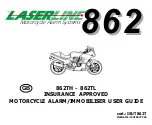
24 • 35-3001A-04-02 Carbon Monoxide Sample-Draw Detector
Calibration Frequency
Although there is no particular calibration frequency that is correct for all applications, a calibration
frequency of every 3 months is adequate for most carbon monoxide sample draw detector
applications. Unless experience in a particular application dictates otherwise, RKI Instruments, Inc.
recommends a calibration frequency of every 3 months for the carbon monoxide sample draw
detector.
If an application is not very demanding, for example detection in a clean, temperature controlled
environment, and calibration adjustments are minimal at calibration, then a calibration frequency of
every 6 months is adequate.
If an application is very demanding, for example if the environment is not well controlled, then
more frequent calibration than every 3 months may be necessary.
Calibration
This section describes how to calibrate the carbon monoxide sensor in the sample-draw detector. It
includes procedures to prepare for calibration, set the zero reading, set the response reading, and
return to normal operation.
NOTE:
Calibrating the sample draw detector may cause alarms. Be sure to put the controller into
its calibration program or disable external alarms before continuing.
NOTE:
This procedure describes calibration using a demand flow regulator.
Preparing for Calibration
NOTE:
If you can verify a fresh air environment, it is not necessary to use a zero air calibrating
sample to set the zero reading at the controller.
1. Follow the instructions in the controller’s operator’s manual for entering calibration mode.
2. Screw the regulator into the zero air calibration cylinder.
3. Open the housing door.
4. Set a voltmeter to measure in the millivolt (mV) range.
5. Plug the positive lead into the red (+) amplifier test point; plug the negative lead into the black
(-) amplifier test point.
6. Use the following formula to determine the correct test points output for the test sample.
Output (mV) = (calibrating sample/fullscale) X 400 + 100
For example, with a test sample of 50 ppm and a fullscale setting of 300 ppm, the correct
output is 167 mV.
167 (mV) = (50/300) X 400 +100



































